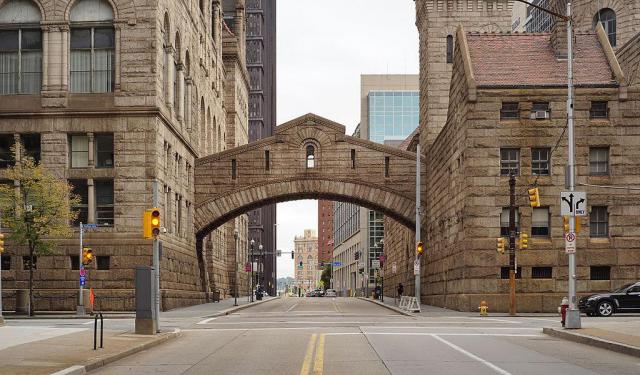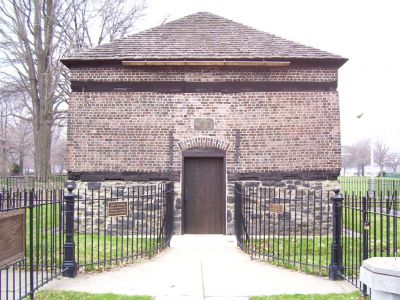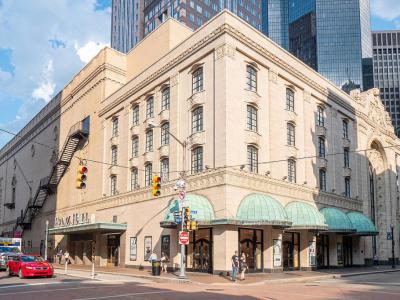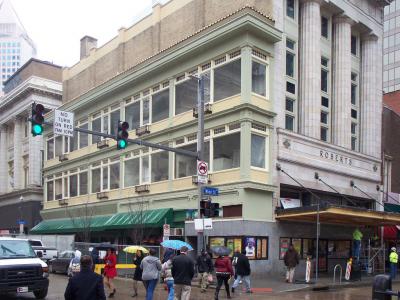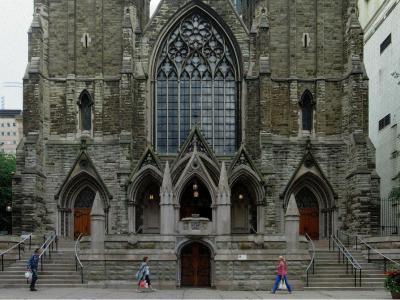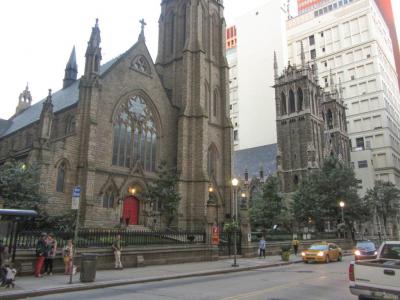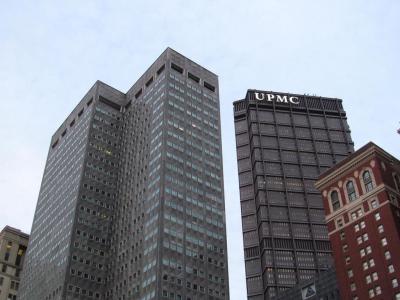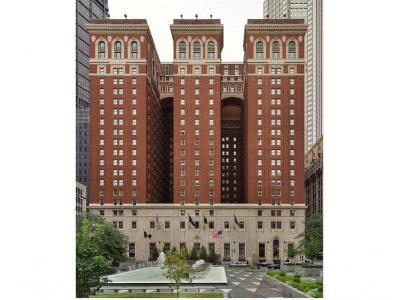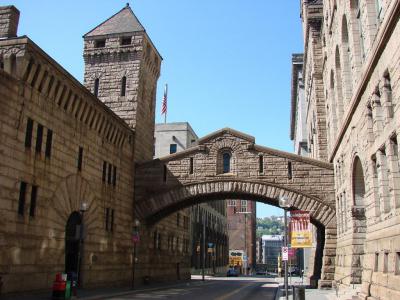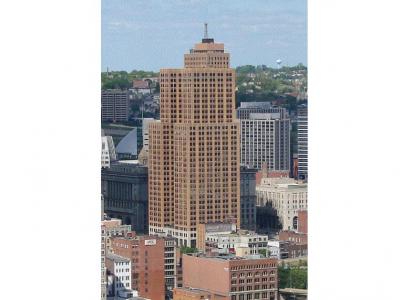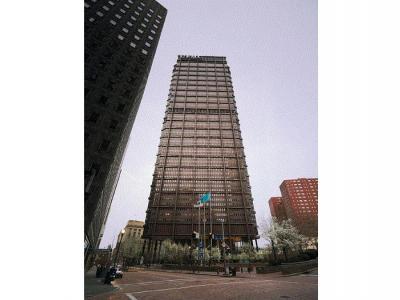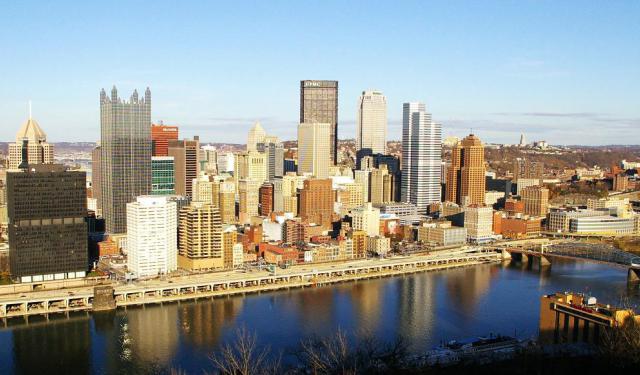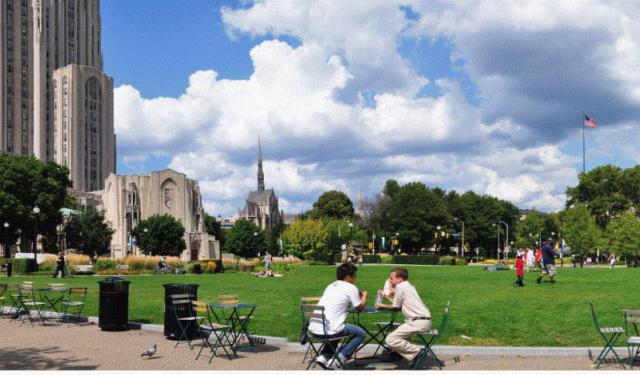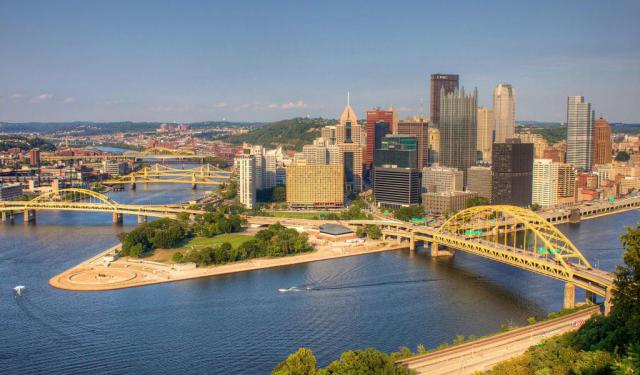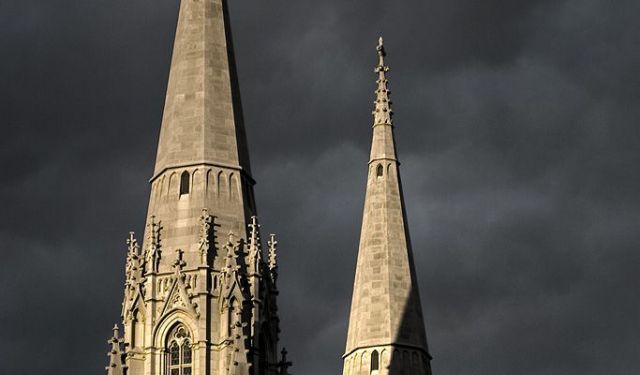Downtown Architectural Jewels (Self Guided), Pittsburgh
Pittsburgh's Downtown is laden with an array of stylish architectural gems. Scattered throughout the city's urban core, these landmarks, some of which date back as far as the 18th century, collectively evoke an air of grandeur and historical significance.
The Fort Pitt Blockhouse, an emblem of resilience and frontier spirit, is the oldest extant structure in Western Pennsylvania, dating back to 1764. Originally part of Fort Pitt, a British fortification during the French and Indian War, its weathered stones remind of a bygone era when the region was a crucible of conflict and settlement.
Nestled amid the bustling Penn Avenue, Heinz Hall is a symphonic sanctuary and an exemplary piece of refined artistry. Built in 1927, this elegant concert hall has been the permanent home of the Pittsburgh Symphony Orchestra since 1971.
In stark contrast to its small footprint, the Hendel Building, affectionately known as the Skinny Building, commands attention with its slender silhouette. Meanwhile, the Grant Building stands as a striking embodiment of the Jazz Age's exuberance and forward-thinking design.
The U.S. Steel Tower, an architectural titan, one of the first built with the use of non-corrosive steel, which was a new invention in the mid-1970s, reigns supreme as the pinnacle of Pittsburgh's modern skyline.
Other architectural marvels in Downtown Pittsburgh include the Regional Enterprise Tower, an architectural trailblazer, holding the distinction of being the world's first all-aluminum building; the Omni William Penn Hotel, a venerable icon of luxury and refined hospitality; the iconic Frick Building skyscraper; and the Old Allegheny County Jail, a silent sentinel of the past, colloquially known as the "Bridge of Sighs"; to mention but a few.
Together, these architectural jewels symbolize the artistic brilliance and engineering prowess that left a firm imprint on the city's identity. Crafted with ingenuity and precision, they attest to the adventurous spirit of Pittsburgh's architectural visionaries who dared to challenge conventional norms and create something truly exceptional. To appreciate their beauty at close range, take this self-guided walking tour. You sure won't be disappointed!
The Fort Pitt Blockhouse, an emblem of resilience and frontier spirit, is the oldest extant structure in Western Pennsylvania, dating back to 1764. Originally part of Fort Pitt, a British fortification during the French and Indian War, its weathered stones remind of a bygone era when the region was a crucible of conflict and settlement.
Nestled amid the bustling Penn Avenue, Heinz Hall is a symphonic sanctuary and an exemplary piece of refined artistry. Built in 1927, this elegant concert hall has been the permanent home of the Pittsburgh Symphony Orchestra since 1971.
In stark contrast to its small footprint, the Hendel Building, affectionately known as the Skinny Building, commands attention with its slender silhouette. Meanwhile, the Grant Building stands as a striking embodiment of the Jazz Age's exuberance and forward-thinking design.
The U.S. Steel Tower, an architectural titan, one of the first built with the use of non-corrosive steel, which was a new invention in the mid-1970s, reigns supreme as the pinnacle of Pittsburgh's modern skyline.
Other architectural marvels in Downtown Pittsburgh include the Regional Enterprise Tower, an architectural trailblazer, holding the distinction of being the world's first all-aluminum building; the Omni William Penn Hotel, a venerable icon of luxury and refined hospitality; the iconic Frick Building skyscraper; and the Old Allegheny County Jail, a silent sentinel of the past, colloquially known as the "Bridge of Sighs"; to mention but a few.
Together, these architectural jewels symbolize the artistic brilliance and engineering prowess that left a firm imprint on the city's identity. Crafted with ingenuity and precision, they attest to the adventurous spirit of Pittsburgh's architectural visionaries who dared to challenge conventional norms and create something truly exceptional. To appreciate their beauty at close range, take this self-guided walking tour. You sure won't be disappointed!
How it works: Download the app "GPSmyCity: Walks in 1K+ Cities" from Apple App Store or Google Play Store to your mobile phone or tablet. The app turns your mobile device into a personal tour guide and its built-in GPS navigation functions guide you from one tour stop to next. The app works offline, so no data plan is needed when traveling abroad.
Downtown Architectural Jewels Map
Guide Name: Downtown Architectural Jewels
Guide Location: USA » Pittsburgh (See other walking tours in Pittsburgh)
Guide Type: Self-guided Walking Tour (Sightseeing)
# of Attractions: 11
Tour Duration: 2 Hour(s)
Travel Distance: 2.6 Km or 1.6 Miles
Author: leticia
Sight(s) Featured in This Guide:
Guide Location: USA » Pittsburgh (See other walking tours in Pittsburgh)
Guide Type: Self-guided Walking Tour (Sightseeing)
# of Attractions: 11
Tour Duration: 2 Hour(s)
Travel Distance: 2.6 Km or 1.6 Miles
Author: leticia
Sight(s) Featured in This Guide:
- Fort Pitt Blockhouse
- Heinz Hall
- Hendel Building (Skinny Building)
- First Presbyterian Church of Pittsburgh
- Trinity Episcopal Cathedral
- Regional Enterprise Tower (World's First All Aluminum Building)
- Omni William Penn Hotel
- Frick Building
- Old Allegheny County Jail
- Grant Building
- U.S. Steel Tower
1) Fort Pitt Blockhouse (must see)
The blockhouse is the only structure left of Fort Pitt, making it the oldest structure in this part of the state. The fort was built in 1764 by the British as a defense against Native American attacks. Later, it was used as a trading post, and then as housing.
After Henry Bouquet stopped the siege at Fort Pitt he ordered the construction of a number of supporting structures around the periphery. The blockhouse is all that remains of his defensive structure. This is thanks to the fact the blockhouse was the only building that remained in use as a house when the fort was demolished in 1792.
Visitors can go to Point State Park to view the Fort Pitt Blockhouse at any time while during the park's open hours. They can view the interior and exterior of the blockhouse to see the full structure of the building.
Outside of the blockhouse is the Edith Ammon Memorial Garden. The landscaping was created to honor the memory of Edith Ammon, who was instrumental in preserving the blockhouse. Indeed, Ammon helped the Pittsburgh chapter of the Daughter's of the Revolution gain ownership of the Fort Pitt Blockhouse. They then restored it and opened it to the public in 1894.
Point State Park is located at the confluence of the Ohio and Monongahela Rivers. Tourists to the park can walk along the Three Rivers Heritage Trail, which will lead them to the Fort Pitt blockhouse as well as the accompanying museum. They can also take the time to visit Fort Duquesne and the Point State Park Fountain.
Why You Should Visit:
To see an important piece of American Revolutionary history
To view the building techniques of simple structures from the late 18th century
Tips:
There is no cost to visit the Fort Pitt blockhouse. It is open during daylight hours on weekends throughout the year. From April through October, the fort is open on Wednesdays and Thursdays as well.
After Henry Bouquet stopped the siege at Fort Pitt he ordered the construction of a number of supporting structures around the periphery. The blockhouse is all that remains of his defensive structure. This is thanks to the fact the blockhouse was the only building that remained in use as a house when the fort was demolished in 1792.
Visitors can go to Point State Park to view the Fort Pitt Blockhouse at any time while during the park's open hours. They can view the interior and exterior of the blockhouse to see the full structure of the building.
Outside of the blockhouse is the Edith Ammon Memorial Garden. The landscaping was created to honor the memory of Edith Ammon, who was instrumental in preserving the blockhouse. Indeed, Ammon helped the Pittsburgh chapter of the Daughter's of the Revolution gain ownership of the Fort Pitt Blockhouse. They then restored it and opened it to the public in 1894.
Point State Park is located at the confluence of the Ohio and Monongahela Rivers. Tourists to the park can walk along the Three Rivers Heritage Trail, which will lead them to the Fort Pitt blockhouse as well as the accompanying museum. They can also take the time to visit Fort Duquesne and the Point State Park Fountain.
Why You Should Visit:
To see an important piece of American Revolutionary history
To view the building techniques of simple structures from the late 18th century
Tips:
There is no cost to visit the Fort Pitt blockhouse. It is open during daylight hours on weekends throughout the year. From April through October, the fort is open on Wednesdays and Thursdays as well.
2) Heinz Hall
Heinz Hall was originally known as Loew's Penn Theater when it was constructed in 1927. Originally, the theater showed films. Today, Heinz Hall is known as home to the Pittsburgh Symphony Orchestra and the Youth Symphony Orchestra.
The original architectural firm was Rapp & Rapp. The Rapp brothers were well known for designing grand movie palaces like the Chicago Theatre. The firm also designed the Paramount Theatre in Times Square. They brought their trademark grandeur to Loew's Penn Theater as well.
The theater originally held one-ton chandeliers and a 50-foot high vaulted, Venetian ceiling. A refurbishment took place in 1971 and again in 1995. The chandeliers were rebuilt, the building was expanded an entrance with a 40-foot high arched window was added. The bulk of the architecture has remained intact over the years. Most of the refurbishments have been done to enhance the experiences of theater goers and to add more space for orchestral events.
The original architectural firm was Rapp & Rapp. The Rapp brothers were well known for designing grand movie palaces like the Chicago Theatre. The firm also designed the Paramount Theatre in Times Square. They brought their trademark grandeur to Loew's Penn Theater as well.
The theater originally held one-ton chandeliers and a 50-foot high vaulted, Venetian ceiling. A refurbishment took place in 1971 and again in 1995. The chandeliers were rebuilt, the building was expanded an entrance with a 40-foot high arched window was added. The bulk of the architecture has remained intact over the years. Most of the refurbishments have been done to enhance the experiences of theater goers and to add more space for orchestral events.
3) Hendel Building (Skinny Building)
The Hendel Building, often referred to as the Skinny Building, stands as an architectural curiosity nestled in the heart of Downtown Pittsburgh. With its minuscule width of just 5 feet 2 inches (1.57 meters), it claims the title of one of the world's narrowest commercial buildings. This slender construction presents a striking contrast to the conventional urban landscape, drawing parallels with Vancouver's Sam Kee Building, which holds the Guinness World Record for the narrowest building, measuring 4 feet 11 inches (1.50 meters) across its ground floor. However, the Sam Kee Building is famous for its second-floor bay windows, which are 6 feet wide, slightly wider than Pittsburgh's Skinny Building.
The origins of the Skinny Building trace back to a unique set of circumstances in 1903, following a street-widening project that left behind an unusually narrow lot. In 1926, Louis Hendel capitalized on this slender parcel of land to erect the building, partly motivated by a desire to retaliate against neighboring business owners who had criticized him for his fruit-selling venture that occupied the sidewalk. This construction not only served as a form of spite but also manifested Hendel's entrepreneurial spirit in a tangible, albeit narrow, form.
Despite its constrained dimensions, the Skinny Building's ground floor has hosted a diverse array of businesses over the years, including a notably popular lunch counter. The upper floors, however, due to their limited space, have seen little to no practical use. Adding to its historical significance, the building is recognized on the National Register of Historic Places, where it is listed as a contributing property within the Fourth Avenue Historic District.
The origins of the Skinny Building trace back to a unique set of circumstances in 1903, following a street-widening project that left behind an unusually narrow lot. In 1926, Louis Hendel capitalized on this slender parcel of land to erect the building, partly motivated by a desire to retaliate against neighboring business owners who had criticized him for his fruit-selling venture that occupied the sidewalk. This construction not only served as a form of spite but also manifested Hendel's entrepreneurial spirit in a tangible, albeit narrow, form.
Despite its constrained dimensions, the Skinny Building's ground floor has hosted a diverse array of businesses over the years, including a notably popular lunch counter. The upper floors, however, due to their limited space, have seen little to no practical use. Adding to its historical significance, the building is recognized on the National Register of Historic Places, where it is listed as a contributing property within the Fourth Avenue Historic District.
4) First Presbyterian Church of Pittsburgh
The First Presbyterian Church is nestled among the high rises of downtown Pittsburgh. The Neo-Gothic designed church was built in 1905 by Theophilus P. Chandler Jr. It has 253 stained glass windows, 13 of which were painted by hand by Tiffany Studios. The church has a wooden ceiling and a pipe organ with 4,400 individual pipes in a Baroque-style casing.
Visitors are welcome to the church service on Sundays where they can worship while also admiring the interior architecture. Those who prefer to view the church's exterior still have plenty to admire.
Along with the building's facade, tourists can step next door to view the historic cemetery, which is located between the First Presbyterian Church and Trinity Episcopal Cathedral. The Trinity Burying Ground is the oldest cemetery in Pittsburgh. Some of the graves date to the 1800s, including that of congressperson James S. Stevenson.
Visitors are welcome to the church service on Sundays where they can worship while also admiring the interior architecture. Those who prefer to view the church's exterior still have plenty to admire.
Along with the building's facade, tourists can step next door to view the historic cemetery, which is located between the First Presbyterian Church and Trinity Episcopal Cathedral. The Trinity Burying Ground is the oldest cemetery in Pittsburgh. Some of the graves date to the 1800s, including that of congressperson James S. Stevenson.
5) Trinity Episcopal Cathedral
Trinity Cathedral serves as the main cathedral for the Episcopal Diocese of Pittsburgh. The current Gothic-style church, which is the third building to accommodate the congregation, was finished in 1872 on the location of an old hilltop cemetery. This spot, situated on a terrace overlooking the historic "point" where the Allegheny River and the Monongahela River meet to form the Ohio River, held significance for Native Americans as a burial site. Early settlers also utilized it as a cemetery, and the congregation erected its second church there in 1824.
Trinity Churchyard contains the oldest marked graves west of the Atlantic Seaboard, including those of Native American leaders, French, English, and American colonists. The initial Trinity Church was constructed two blocks to the west of this burial ground at the foot of the hill or terrace during the late 18th and early 19th centuries.
In 1824, Trinity relocated to its present location in the middle of the churchyard on the terrace, featuring what is considered the first Gothic-style structure in Western Pennsylvania. John Henry Hopkins oversaw the design and building of the cathedral, which included buttresses, a tower, pointed arches, and a vaulted ceiling. The new Trinity Cathedral was completed in 1872, standing as the tallest building in the city until the construction of the Allegheny County Courthouse in 1888.
Trinity Churchyard contains the oldest marked graves west of the Atlantic Seaboard, including those of Native American leaders, French, English, and American colonists. The initial Trinity Church was constructed two blocks to the west of this burial ground at the foot of the hill or terrace during the late 18th and early 19th centuries.
In 1824, Trinity relocated to its present location in the middle of the churchyard on the terrace, featuring what is considered the first Gothic-style structure in Western Pennsylvania. John Henry Hopkins oversaw the design and building of the cathedral, which included buttresses, a tower, pointed arches, and a vaulted ceiling. The new Trinity Cathedral was completed in 1872, standing as the tallest building in the city until the construction of the Allegheny County Courthouse in 1888.
6) Regional Enterprise Tower (World's First All Aluminum Building)
Regional Enterprise Tower was the world's first aluminum building. Fittingly, the building was crafted for the Aluminum Company of America, or Alcoa. Locals still refer to the skyscraper as the Alcoa Building though that company hasn't held its offices in this building since 2001.
Construction began on the Regional Enterprise Tower in 1950 and completed in 1953. Architectural firm Harrison & Abramovitz designed the 410 foot tall on the grounds of the Nixon Theater. The duo also designed such notable structures as New York's Metropolitan Opera House at the Lincoln Center for the Performing Arts and the US Steel Tower, also located in Pittsburgh.
The Regional Enterprise Tower now contains office and retail space along with more than 200 residential apartments. The interior of the building utilizes the same aluminum material to accent support beams, fireplaces, ceilings and wall features. Those interested in seeing how aluminum was used to create a light and sturdy building should include the Regional Enterprise Tower on their tour of the city.
Construction began on the Regional Enterprise Tower in 1950 and completed in 1953. Architectural firm Harrison & Abramovitz designed the 410 foot tall on the grounds of the Nixon Theater. The duo also designed such notable structures as New York's Metropolitan Opera House at the Lincoln Center for the Performing Arts and the US Steel Tower, also located in Pittsburgh.
The Regional Enterprise Tower now contains office and retail space along with more than 200 residential apartments. The interior of the building utilizes the same aluminum material to accent support beams, fireplaces, ceilings and wall features. Those interested in seeing how aluminum was used to create a light and sturdy building should include the Regional Enterprise Tower on their tour of the city.
7) Omni William Penn Hotel
The Omni William Penn hotel is located in downtown Pittsburgh next to Mellon Square. It was known as the "Grandest Hotel in the World" at the time it was built. Since then, it has seen its share of notable guests. Faces that have graced the hotel include John F. Kennedy, Bob Hope, Ronald Reagan, Harry S Truman and Dwight D. Eisenhower.
The building was erected in 1916 as the William Penn Hotel, owned by the Pittsburgh Hotel Company. It was crafted in the Neoclassical style by architectural firm Janssen & Abbott. In 1929 the hotel was expanded to become the second largest in the world.
The interior of the hotel is outfitted in Art Deco style that benefited in 1984 from a $20 million remodeling that expanded the size of the rooms and reduce the number of guests rooms from the previous 1,600 to 650. Visitors to the hotel will see domed arches, tufted sofas, wooden accents a speakeasy that evokes the feel of the 1920s.
The building was erected in 1916 as the William Penn Hotel, owned by the Pittsburgh Hotel Company. It was crafted in the Neoclassical style by architectural firm Janssen & Abbott. In 1929 the hotel was expanded to become the second largest in the world.
The interior of the hotel is outfitted in Art Deco style that benefited in 1984 from a $20 million remodeling that expanded the size of the rooms and reduce the number of guests rooms from the previous 1,600 to 650. Visitors to the hotel will see domed arches, tufted sofas, wooden accents a speakeasy that evokes the feel of the 1920s.
8) Frick Building
The Frick Building, in Downtown Pittsburgh, is named after Henry Clay Frick, a notable industrialist known for his involvement in coke production and the development of commercial buildings in the city. It holds a significant place in history as it is listed on the National Register of Historic Places.
Constructed adjacent to a building owned by his former business partner turned rival, Andrew Carnegie, the Frick Building was strategically designed to overshadow Carnegie's structure, symbolizing Frick's ongoing feud with him.
Opening its doors on March 15, 1902, with 20 floors initially, it claimed the title of the city's tallest building. However, alterations in the surrounding landscape in 1912 led to its basement becoming the main entrance, resulting in debates over whether it should be credited with 21 stories.
Designed by Daniel H. Burnham of D.H. Burnham & Company, Chicago, the Frick Building is one of the surviving projects out of eleven planned designs for Pittsburgh by the firm.
Noteworthy features include the top floor reserved for The Union Club of Pittsburgh, adorned with a balcony, handcrafted ceiling, and ornate brass fixtures. Originally serving as H.C. Frick's personal office and a gathering place for wealthy industrialists, it even housed Frick's personal shower on the 19th floor, a technological marvel of its time.
The building's lobby boasts a stunning stained-glass window by John LaFarge, depicting "Fortune and Her Wheel" (1902), along with bronze sentinel lions by sculptor Alexander Proctor (1904) and a bust of Frick by sculptor Malvina Hoffman (1923).
At one point, the building served as the headquarters for Frick's family whiskey business, Old Overholt, overseeing its operations across the United States.
Constructed adjacent to a building owned by his former business partner turned rival, Andrew Carnegie, the Frick Building was strategically designed to overshadow Carnegie's structure, symbolizing Frick's ongoing feud with him.
Opening its doors on March 15, 1902, with 20 floors initially, it claimed the title of the city's tallest building. However, alterations in the surrounding landscape in 1912 led to its basement becoming the main entrance, resulting in debates over whether it should be credited with 21 stories.
Designed by Daniel H. Burnham of D.H. Burnham & Company, Chicago, the Frick Building is one of the surviving projects out of eleven planned designs for Pittsburgh by the firm.
Noteworthy features include the top floor reserved for The Union Club of Pittsburgh, adorned with a balcony, handcrafted ceiling, and ornate brass fixtures. Originally serving as H.C. Frick's personal office and a gathering place for wealthy industrialists, it even housed Frick's personal shower on the 19th floor, a technological marvel of its time.
The building's lobby boasts a stunning stained-glass window by John LaFarge, depicting "Fortune and Her Wheel" (1902), along with bronze sentinel lions by sculptor Alexander Proctor (1904) and a bust of Frick by sculptor Malvina Hoffman (1923).
At one point, the building served as the headquarters for Frick's family whiskey business, Old Overholt, overseeing its operations across the United States.
9) Old Allegheny County Jail
The old Allegheny County Jail, built between 1884 and 1886, was in continual use for over 100 years. Among the most notable former prisoners was Alexander Berkman, who was held at the county jail while awaiting trial. Jack and Ed Biddle were notorious prisoners who escaped with the help of the warden's wife who had developed a relationship with the brothers.
In 1972, the jail was added to the list of Pittsburgh historic designations. It was named as a National Historic Landmark in 1976. In the late 1990s, the Allegheny County Jail was converted into a family courthouse, which is a purpose it continues to serve to this day.
The jail was built by the Norcross Brothers and designed by architect H.H. Richardson in the Romanesque Revival style. Visitors can enjoy the beauty of the building's exterior, but they are welcome indoors as well. The interior is open for tours and contains the Old Allegheny County Jail Museum. A self-guided tour is available. Docents are also on-hand to answer any questions.
Visitors should be aware that the interior is only open on Mondays. Likewise, as it is a working courthouse, tourists must pass through a metal detector. No photography is allowed inside.
In 1972, the jail was added to the list of Pittsburgh historic designations. It was named as a National Historic Landmark in 1976. In the late 1990s, the Allegheny County Jail was converted into a family courthouse, which is a purpose it continues to serve to this day.
The jail was built by the Norcross Brothers and designed by architect H.H. Richardson in the Romanesque Revival style. Visitors can enjoy the beauty of the building's exterior, but they are welcome indoors as well. The interior is open for tours and contains the Old Allegheny County Jail Museum. A self-guided tour is available. Docents are also on-hand to answer any questions.
Visitors should be aware that the interior is only open on Mondays. Likewise, as it is a working courthouse, tourists must pass through a metal detector. No photography is allowed inside.
10) Grant Building
The Grant Building stands proudly on Grant Street in Pittsburgh, a street historically significant for the city's corporate and governmental affairs. Completed in 1930, this towering structure boasts thirty-seven floors, reaching a height of 485 feet above downtown Pittsburgh. Its façade, fashioned in the art deco style, showcases a blend of Belgian granite, limestone, and brick.
One notable feature of the building was its radio antenna, extending approximately 100–150 feet from the tower's roof, equipped with an aviation beacon that transmitted the Morse Code message "P-I-T-T-S-B-U-R-G-H". This beacon, visible up to 150 miles away on clear nights, served as a distinctive landmark. Despite occasional malfunctions in the older technology, a smaller version of the beacon continues to flash the city's name, albeit with occasional misspellings like "P-I-T-E-T-S-B-K-R-R-H". Fortunately, repairs in July 2009 restored the beacon's functionality, once again proudly illuminating the correct spelling of Pittsburgh.
Additionally, the tower on the roof doubled as the broadcast antenna for radio station KDKA Pittsburgh, renowned for making the first commercially licensed radio broadcast on the memorable election night of 1920.
One notable feature of the building was its radio antenna, extending approximately 100–150 feet from the tower's roof, equipped with an aviation beacon that transmitted the Morse Code message "P-I-T-T-S-B-U-R-G-H". This beacon, visible up to 150 miles away on clear nights, served as a distinctive landmark. Despite occasional malfunctions in the older technology, a smaller version of the beacon continues to flash the city's name, albeit with occasional misspellings like "P-I-T-E-T-S-B-K-R-R-H". Fortunately, repairs in July 2009 restored the beacon's functionality, once again proudly illuminating the correct spelling of Pittsburgh.
Additionally, the tower on the roof doubled as the broadcast antenna for radio station KDKA Pittsburgh, renowned for making the first commercially licensed radio broadcast on the memorable election night of 1920.
11) U.S. Steel Tower
The U.S. Steel Tower, also known as the Steel Building, is located on Grant Street and holds the title of Pittsburgh's tallest skyscraper. It ranks as the fourth tallest in Pennsylvania and the 37th tallest in the entire United States. Its construction finished in 1970, boasting an impressive 64 floors reaching a height of 841 feet (256 meters). Notably, the tower's design features a distinctive triangular shape with recessed corners.
An architectural milestone was achieved with the implementation of liquid-filled fireproofed columns, a groundbreaking innovation at the time. U.S. Steel strategically positioned these robust steel columns on the building's exterior to showcase the innovative Cor-ten steel. This special steel type, resistant to various weather conditions like rain, snow, and fog, forms a protective layer of dark brown oxidation over time. This coating prevents further corrosion, eliminating the need for frequent painting and expensive rust-prevention maintenance.
Initially, the weathering process led to some discoloration of the surrounding city sidewalks and nearby structures. Although a cleanup initiative was undertaken by the corporation after the weathering was completed, traces of rust remain evident on the sidewalks. The Cor-Ten steel used for the tower was manufactured at the former U.S. Steel Homestead Works. With over 44,000 U.S. tons (40,000 metric tons) of structural steel and nearly an acre of office space per floor, the tower stands as a symbol of architectural and engineering excellence.
An architectural milestone was achieved with the implementation of liquid-filled fireproofed columns, a groundbreaking innovation at the time. U.S. Steel strategically positioned these robust steel columns on the building's exterior to showcase the innovative Cor-ten steel. This special steel type, resistant to various weather conditions like rain, snow, and fog, forms a protective layer of dark brown oxidation over time. This coating prevents further corrosion, eliminating the need for frequent painting and expensive rust-prevention maintenance.
Initially, the weathering process led to some discoloration of the surrounding city sidewalks and nearby structures. Although a cleanup initiative was undertaken by the corporation after the weathering was completed, traces of rust remain evident on the sidewalks. The Cor-Ten steel used for the tower was manufactured at the former U.S. Steel Homestead Works. With over 44,000 U.S. tons (40,000 metric tons) of structural steel and nearly an acre of office space per floor, the tower stands as a symbol of architectural and engineering excellence.
Walking Tours in Pittsburgh, Pennsylvania
Create Your Own Walk in Pittsburgh
Creating your own self-guided walk in Pittsburgh is easy and fun. Choose the city attractions that you want to see and a walk route map will be created just for you. You can even set your hotel as the start point of the walk.
Pittsburgh Introduction Walking Tour
Pittsburgh is the second largest city in Pennsylvania. The metro area is also the largest in Appalachia, the Ohio Valley and one of the most populous in the country. It known colloquially as "Steel City" due to its mainstay as a leader in manufacturing steel and other important materials like glass and aluminum. Pittsburgh also holds an important place in the history of the United... view more
Tour Duration: 2 Hour(s)
Travel Distance: 3.2 Km or 2 Miles
Tour Duration: 2 Hour(s)
Travel Distance: 3.2 Km or 2 Miles
Oakland District Walking Tour
Welcome to Oakland, an academic and cultural center of Pittsburgh! Representing a harmonious blend of intellectual prowess, cultural marvels, and natural splendor, this captivating neighborhood brims with attractions to overlook which would be a terrible miss!
As a manifestation of the transformative power of knowledge and creativity, Oakland, in large part, owes its status to the 19th-century... view more
Tour Duration: 2 Hour(s)
Travel Distance: 2.8 Km or 1.7 Miles
As a manifestation of the transformative power of knowledge and creativity, Oakland, in large part, owes its status to the 19th-century... view more
Tour Duration: 2 Hour(s)
Travel Distance: 2.8 Km or 1.7 Miles
Mount Washington Walking Tour
Mount Washington is a hill on the southern banks of the Monongahela River and Ohio River. Due to its elevated position, the top of the hill offers a spectacular view of Downtown Pittsburgh below. The Mount is a prime tourist attraction in the city, and many photos and drawings of the Pittsburgh skyline have originated here.
If you want to see what Pittsburgh looks like from above, take this... view more
Tour Duration: 1 Hour(s)
Travel Distance: 1.8 Km or 1.1 Miles
If you want to see what Pittsburgh looks like from above, take this... view more
Tour Duration: 1 Hour(s)
Travel Distance: 1.8 Km or 1.1 Miles
Pittsburgh's Historical Churches
Pittsburgh's storied landscape is interwoven with the resplendent charm of its historical churches. Apart from being testaments to the city's rich religious heritage and the enduring spirit of faith, these abodes of worship stand as venerable monuments, whose architectural splendor etched an indelible mark on Pittsburgh.
Foremost among them is the First Presbyterian Church. This... view more
Tour Duration: 1 Hour(s)
Travel Distance: 1.4 Km or 0.9 Miles
Foremost among them is the First Presbyterian Church. This... view more
Tour Duration: 1 Hour(s)
Travel Distance: 1.4 Km or 0.9 Miles
The Most Popular Cities
/ view all
